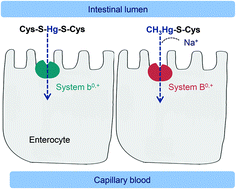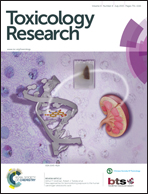Participation of b0,+ and B0,+ systems in the transport of mercury bound to cysteine in intestinal cells
Abstract
The main source of exposure to mercury (Hg) as divalent inorganic Hg [Hg(II)] and methylmercury (CH3Hg) is the diet, in which complexes with the amino acid cysteine (Hg–Cys) may be found. The present study explores the participation of the b0,+ and B0,+ amino acid transporters in the intestinal transport of mercuric conjugates with cysteine [Hg(II)–Cys and CH3Hg–Cys], using Caco-2 cells as a model of the intestinal epithelium. For this purpose, the effects of b0,+ and B0,+ gene silencing upon Hg(II)–Cys and CH3Hg–Cys uptake were evaluated. In addition, after treatment with Hg–Cys complexes, we evaluated the differential expression of b0,+ and B0,+ and of transporters belonging to the LAT and y+LAT systems, which have also been described as possible participants in the Hg–Cys transport. The results show that b0,+ and B0,+ silencing reduces intracellular accumulation of Hg(II)–Cys (39 ± 8%) and CH3Hg–Cys (16 ± 3%), respectively. These results, together with the existing literature, suggest that these transporters are involved in the transport of Hg–Cys in intestinal cells. On the other hand, the differential expression studies reflect an increase in LAT and y+LAT transporters after treatment with Hg–Cys, which could indicate their participation in the cellular elimination of such complexes, as has been previously suggested.


 Please wait while we load your content...
Please wait while we load your content...